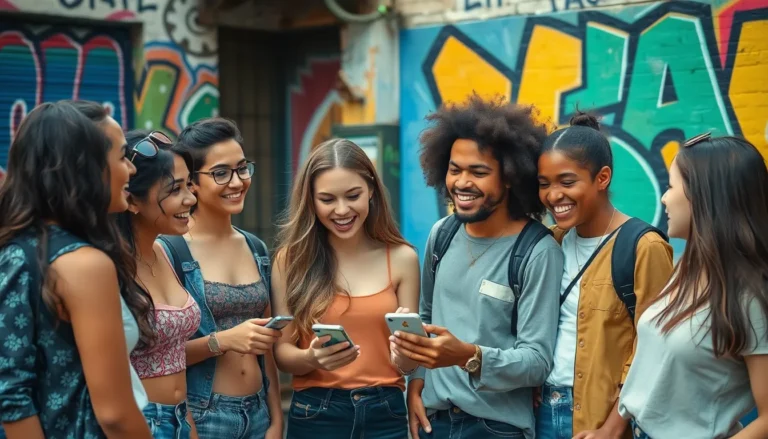Fashion in India is like a vibrant festival, constantly evolving and bursting with colors. As the seasons change, so do the styles, leaving everyone eager to discover what’s hot and what’s not. From the bustling streets of Mumbai to the chic boutiques of Delhi, the latest trends are making waves and turning heads faster than you can say “saree not sorry.”
Table of Contents
ToggleOverview of Latest Fashion Trends in India
Current fashion trends in India exhibit a blend of traditional aesthetics and modern influences. Designers often combine vibrant colors with bold patterns, showcasing regional crafts alongside contemporary styles. Ethnic wear, such as sarees and lehengas, continues to hold a significant place in wardrobes, yet contemporary silhouettes gain popularity, appealing to younger audiences.
Street style in metropolitan cities, like Mumbai and Delhi, reflects individuality and creativity. In these urban settings, relaxed fits and oversized garments dominate casual attire, encouraging self-expression and comfort. Athleisure also gains traction among fashion enthusiasts, merging functionality and style.
Sustainable fashion has entered the scene, with designers focusing on eco-friendly materials and ethical production practices. Consumers increasingly prioritize brands that value sustainability while providing unique fashion choices. This trend fosters a deeper connection to the environment and cultural heritage.
Seasonal collections showcase fresh color palettes, with pastel shades becoming popular during warmer months. Contrastingly, deeper, richer tones mark the fall and winter seasons. Accessories play an essential role in current trends, with statement jewelry and handcrafted bags elevating outfits to new heights.
Fashion weeks across India highlight emerging talents, bringing innovative designs to the forefront. Events in cities, such as Mumbai and Bangalore, celebrate the diversity of Indian fashion, allowing designers to experiment and push boundaries. Each season introduces new faces and ideas, ensuring the industry remains vibrant and ever-evolving.
Traditional Indian Wear Reinvented
Traditional Indian wear undergoes a refreshing transformation, blending cultural heritage with modern aesthetics. Designers infuse traditional garments with contemporary styles, creating pieces that appeal to a wide audience.
Sarees with Modern Twists
Sarees now embrace innovative elements, showcasing draping techniques that differ significantly from classics. Designers experiment with unconventional fabrics and asymmetrical silhouettes. Bold colors, along with striking prints, rejuvenate the traditional saree, attracting younger generations. Mix and match options emerge, allowing wearers to pair sarees with crop tops or jackets, adding a fresh perspective. Sustainability becomes a key focus as many opt for handcrafted sarees made from eco-friendly materials.
Ethnic Wear for Men
Men’s ethnic wear adapts to modern sensibilities while maintaining traditional charm. Kurta sets and sherwanis explore fresh cuts, featuring relaxed fits that prioritize comfort. Fabrics like linen and cotton receive renewed attention for their breathability, suited for diverse weather conditions. Intricate embroidery and bold patterns become prominent as men embrace vibrant styles. Accessories such as colorful turbans and embellished loafers complete the look, emphasizing individuality. This evolution makes ethnic wear a popular choice for various occasions.
Western Influences in Indian Fashion
Western influences increasingly shape Indian fashion, blending diverse styles and aesthetics. The incorporation of global trends brings freshness and innovation to traditional attire.
Bohemian Style
Bohemian style resonates with many in urban India, characterized by flowing fabrics and vibrant patterns. Designers now offer maxis and boho-chic layers, often inspired by Western fashion. Ethnic prints merge with bohemian silhouettes, resulting in unique outfits that highlight individuality. Earthy tones and fringe details appeal to those seeking a relaxed, unconventional look. Accessories like large earrings and layered necklaces complete the bohemian ensemble, enhancing its artistic vibe.
Streetwear Culture
Streetwear culture captures the essence of urban Indian youth, merging comfort with edgy fashion. Graphic tees, oversized hoodies, and distressed jeans dominate casual looks, inspired by global street fashion. Sneakers, especially limited-edition releases, play a vital role in this trend. Local brands are now creating unique designs that reflect regional aesthetics while embracing worldwide influences. Individuals express their creativity through mix-and-match styles, showcasing their personalities effortlessly.
Sustainability in Fashion
Sustainability shapes the evolving fashion landscape in India. Designers increasingly adopt eco-friendly practices and materials to appeal to conscious consumers.
Eco-Friendly Fabrics
Organic cotton, linen, and Tencel lead the charge for sustainable materials in India. These fabrics reduce environmental impact compared to conventional alternatives. Innovative brands focus on natural dyes and non-toxic finishes, prioritizing health alongside style. Their efforts enhance breathability and comfort while promoting responsible consumption. Eco-conscious fashion shows showcase collections that blend sustainability with aesthetics, attracting eco-friendly shoppers. This trend reflects a broader awareness of global environmental issues, prompting brands to embrace transparency in sourcing and manufacturing processes.
Upcycling and Thrift Fashion
Upcycling transforms old garments into fashionable pieces, promoting creativity and sustainability. Individuals and brands engage in remaking clothing by adding embellishments or restructuring designs, resulting in unique styles. Thrift fashion gains momentum as consumers seek vintage and pre-owned items, reducing waste and supporting circular economies. Online platforms and local thrift stores flourish, offering curated selections to fashion-forward shoppers. Exploring these options encourages a shift toward sustainable consumption habits and values. Moreover, the rise of social media has facilitated a vibrant community centered on sharing tips for thrifting and upcycling, further driving interest in eco-friendly fashion practices across India.
Popular Designers and Brands
Indian fashion showcases an array of influential designers and brands redefining style norms. Sabyasachi Mukherjee stands out for his luxurious bridal wear, blending traditional craftsmanship with contemporary aesthetics. Manish Malhotra, known for glamorous ensembles, often dresses Bollywood celebrities, making him a prominent figure in the fashion scene.
Anita Dongre emphasizes sustainable practices while offering elegant attire that highlights India’s cultural heritage. Tarun Tahiliani combines intricate embroidery with modern silhouettes, appealing to those seeking unique fashion statements. Designers like Abu Jani Sandeep Khosla focus on opulent textiles, pushing boundaries in ethnic wear.
Streetwear brands such as Nicobar and Doodlage are gaining traction, representing India’s bustling urban culture. These brands produce contemporary clothing that resonates with the youth, showcasing inventive designs using sustainable materials. Similarly, brand house All About India features handcrafted pieces, merging tradition with modernity.
Regional designers like Neeta Lulla focus on practical yet stylish garments that cater to diverse tastes. She often draws inspiration from Classical Indian dance forms to create unique looks. Labels such as Fabindia emphasize organic fabrics, celebrating Indian craftsmanship while aligning with eco-friendly principles.
As established names maintain their influence, new designers emerge consistently, inspired by ever-changing trends. Labels like The Pondicherry Company bring forth vivid colors and unique patterns that connect with local artisan communities. Their collections reflect a vibrant blend of cultures and innovations, enhancing India’s fashion diversity.
Seasonal trends continue to transform the market, with local fashion weeks spotlighting fresh talent and creativity. Engaging runway shows allow designers to unveil new collections, affirming their commitment to evolving the Indian fashion landscape.
The fashion landscape in India is a captivating blend of tradition and modernity. As styles evolve and new trends emerge, there’s an undeniable excitement in the air. From the vibrant streets of Mumbai to the chic boutiques of Delhi, individuals are embracing diverse aesthetics that reflect their unique personalities.
Sustainability is becoming a key focus, with designers prioritizing eco-friendly materials and ethical practices. This shift not only caters to environmentally conscious consumers but also fosters creativity in the industry. As Indian fashion continues to reinvent itself, it remains a vibrant tapestry of culture and innovation, ensuring that it will always be a source of inspiration for fashion enthusiasts everywhere.





